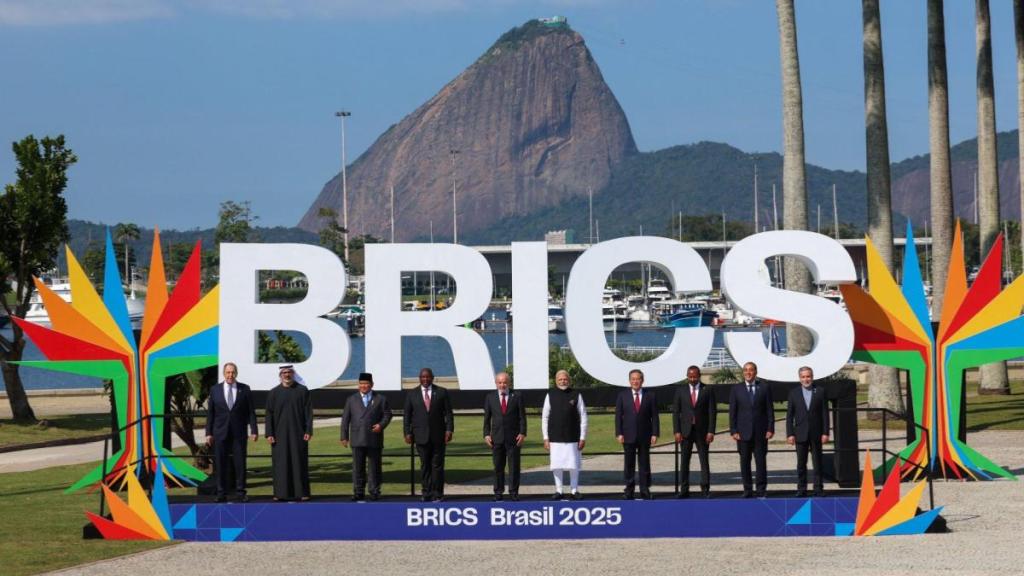By Anita Inder Singh, Founding Professor, Centre for Peace and Conflict Resolution, New Delhi
What brought together Brazil, Russia, India, China, and South Africa (BRICS), along with six new members—Egypt, Ethiopia, Iran, Saudi Arabia, the United Arab Emirates, and Indonesia—at the latest BRICS+ summit in Rio de Janeiro was their common desire to explore new ways of dealing with their development problems. At its annual leaders’ summit held in Brazil on July 6 and 7, the group urged new partnerships in pursuit of multilateralism, trade, and development—rather than a world driven by military alliances or ideology. As a loose grouping that includes authoritarian (China, Russia) and democratic (Brazil, India, South Africa) states, BRICS is not unique: the United Nations (UN) and the Commonwealth also comprise autocracies and democracies.
BRICS is not synonymous with a new world order. That unfortunately has been marked by Russia’s ongoing invasion of Ukraine, Israel’s use of starvation as a tactic in its war against Gaza, and US President Donald Trump’s disruptive foreign and economic policies which have led him to deal with the US’s European allies as enemies while threatening most countries with trade and tariff wars. Trump’s attack on the nuclear facilities of Iran—one of the new members of BRICS—has also sent international shockwaves. So has what Brazil’s President Luiz Inácio Lula da Silva described as “the genocide carried out by Israel in Gaza”. However, while appearing to criticise the Trump administration’s tariffs and foreign policies, the BRICS final statement did not directly mention him or the US. In short, the ending of one international order—signified by the US’s sudden retreat from multilateralism, international law, and global governance—is not necessarily making way for the sudden arrival of a brave new world led by a larger BRICS group.
Brazil rightly argued that unilateralism was more disruptive than multipolarity. It claimed that US policies on tariffs and sovereignty were accelerating the transition to multipolarity in different ways. But Brazil’s proposals on the effect of the climate crisis on developing countries, green energy transition, cooperation on vaccines, and expanding the most-favoured nation status to all countries in the World Trade Organization were overshadowed by Trump’s economic threats to raise tariffs on BRICS countries by 10%.
Trump is unnecessarily sparking yet another international row. BRICS member-states are dissatisfied with the policies of western-led financial institutions, including the International Monetary Fund and World Bank. They are also frustrated with the dollar’s status as a reserve currency, but there is no intention to de-dollarise. Hosting the BRICS summit in Kazan in 2024, Russia had called for a reassessment of the dollar’s central role in global finance. But in Rio de Janeiro, Russia denied that a BRICS currency for payments between members had ever been discussed. Meanwhile, de-dollarisation would not be in the interests of India and China because the US is their largest trading partner and they are struggling to keep Trump’s tariffs against them at bay.
In principle, the enlarged BRICS has the potential to become a major geopolitical and geoeconomic force. The group represents more than 40% of the world’s population and produces 30 % of its oil. BRICS countries have established considerable intergovernmental cooperation. Significantly, China is the largest contributor to the group’s New Development Bank which challenges Western-dominated institutions of global economic governance.
There is considerable uncertainty about whether BRICS+ could become a coherent, anti-Western bloc. Such an outcome would only complicate prospects for multilateralism and may not be attractive to many of its members. Not all of them are hostile even to Trump’s US, which is antagonistic to any country that disagrees with it. India, for example, is a member of the Quad and is currently negotiating a trade deal with the US. China, the greatest challenger to the American superpower, will not move against the US for the sake of the developing world but it will do so to advance its own interests. At another level, China will block India’s accession to permanent membership of the UN Security Council or any criticism of Pakistani-exported terrorism—both were omitted from the final communiqué of the BRICS+ summit. And a group as divided as the BRICS cannot replace Western capitalism represented by the G7.
China’s President Xi Jinping did not attend the BRICS summit in Brazil; China’s premier Li Qiang replaced him. That did take some of the shine off the meeting since Xi has played a major role in making his country the US’s greatest world challenger.
The potential of BRICS members and partner countries to fulfil their individual aspirations via the grouping hinges on which vision of the future of the world order will ultimately play out. Will they be able to create a more egalitarian mode of global governance, hedge against Western instability while maintaining a geopolitical neutrality, or participate in an alternative international economic system outside the reaches of American sanctions? Much will hinge on the degree of common purpose shown by the US’s European allies, whose like-mindedness and solidarity the second Trump administration has suddenly called into question.
Over the past two years, BRICS
has significantly expanded its list of members and partners as countries pursue new economic opportunities, political influence, and greater resilience while Washington retreats from key international institutions. That has raised more hopes about BRICS. However, BRICS remains too divided by a mix of national interests and economic weaknesses—and a continuing dependence on Europe and the US—to gain the spotlight as the champion of multilateralism.


